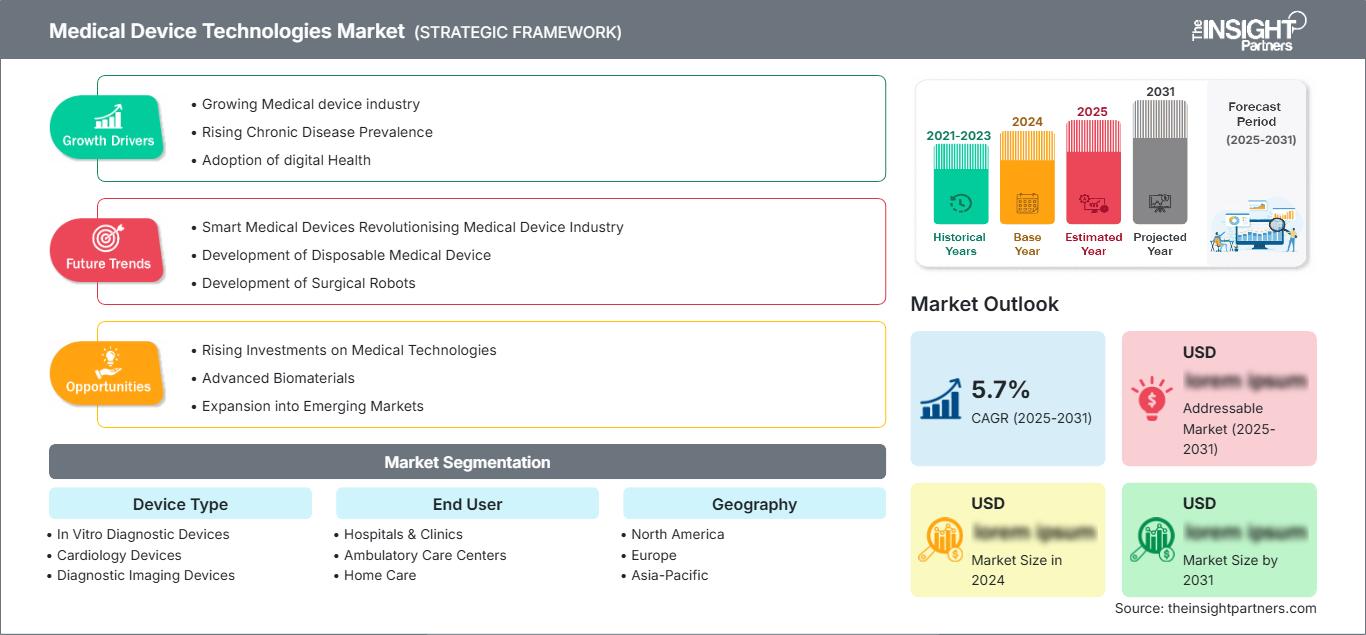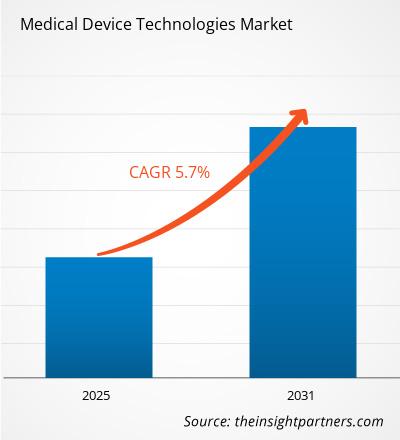Der Markt für Medizintechnik wird bis 2031 voraussichtlich ein Volumen von 690,79 Milliarden US-Dollar erreichen. Für den Zeitraum 2025–2031 wird ein jährliches Wachstum von 7,1 % erwartet.
Der Bericht ist nach Gerätetyp segmentiert (In-vitro-Diagnostika (IVD), Kardiologiegeräte, Geräte für die diagnostische Bildgebung, Orthopädiegeräte, Ophthalmologiegeräte, Endoskopiegeräte, Geräte für die Diabetesversorgung, Wundmanagementgeräte, Nieren-/Dialysegeräte, Anästhesie- und Beatmungsgeräte sowie Sonstige). Darüber hinaus enthält der Bericht eine Analyse basierend auf den Endnutzern (Krankenhäuser und Kliniken, ambulante Versorgungszentren, häusliche Pflege und Sonstige). Die globale Analyse wird weiter auf regionaler Ebene und für wichtige Länder aufgeschlüsselt. Der Bericht gibt den Wert der oben genannten Analysen und Segmente in USD an.
Zweck des Berichts
Der Bericht „Markt für Medizintechniktechnologien“ von The Insight Partners beschreibt die aktuelle Marktlage und das zukünftige Wachstum, die wichtigsten Treiber, Herausforderungen und Chancen. Er bietet Einblicke für verschiedene Akteure im Markt, wie z. B.:
- Technologieanbieter/Hersteller: Um die sich entwickelnde Marktdynamik zu verstehen und potenzielle Wachstumschancen zu erkennen, können sie fundierte strategische Entscheidungen treffen.
- Investoren: Um eine umfassende Trendanalyse hinsichtlich Marktwachstumsrate, Finanzprognosen und Chancen entlang der Wertschöpfungskette durchzuführen.
- Regulierungsbehörden: Um Richtlinien zu regulieren und Aktivitäten auf dem Markt zu überwachen, mit dem Ziel, Missbrauch zu minimieren, das Vertrauen der Investoren zu wahren und die Integrität und Stabilität des Marktes zu gewährleisten. Marktsegmentierung für Medizintechnik nach Gerätetyp
- In-vitro-Diagnostika
- Kardiologische Geräte
- Bildgebende Diagnosegeräte
- Orthopädische Geräte
- Ophthalmologische Geräte
- Endoskopische Geräte
- Diabetes-Therapiegeräte
- Wundmanagementgeräte
- Nieren-/Dialysegeräte
- Anästhesie- und Beatmungsgeräte
- Sonstige
Endnutzer
- Krankenhäuser und Kliniken
- Ambulante Versorgungszentren
- Häusliche Pflege
- Sonstige
Passen Sie diesen Bericht Ihren Anforderungen anSie erhalten kostenlos Anpassungen an jedem Bericht, einschließlich Teilen dieses Berichts oder einer Analyse auf Länderebene, eines Excel-Datenpakets sowie tolle Angebote und Rabatte für Start-ups und Universitäten.
Markt für Medizingerätetechnologien: Strategische Einblicke

-
Holen Sie sich die wichtigsten Markttrends aus diesem Bericht.Dieses KOSTENLOSE Beispiel umfasst Datenanalysen, die von Markttrends bis hin zu Schätzungen und Prognosen reichen.
Wachstumstreiber des Marktes für Medizintechnik
- Wachsende Medizintechnikbranche: Medizinprodukte sind unerlässlich für die Prävention, Diagnose, Behandlung und Rehabilitation von Krankheiten. Laut AdvaMed sind die USA der größte Medizintechnikmarkt weltweit und machen über 40 % des globalen Medizintechnikmarktes aus.
- Zunehmende Prävalenz chronischer Krankheiten: Die steigende Prävalenz chronischer Krankheiten wie neurologischer Erkrankungen, Herz-Kreislauf-Erkrankungen, Krebs, Diabetes, Schlaganfall und Nierenerkrankungen erhöht die Nachfrage nach Medizinprodukten für Diagnose- und Behandlungszwecke. Laut CDC entfallen in den USA 90 % der jährlichen Gesundheitsausgaben (4,5 Billionen US-Dollar) auf Menschen mit chronischen und psychischen Erkrankungen.
- Nutzung digitaler Gesundheitslösungen: Verbesserungen im Bereich der digitalen Gesundheit sind der Schlüsselfaktor für das Wachstum des Marktes für Medizintechnik. Die zunehmende Nutzung digitaler Gesundheitslösungen in der Telemedizin und der Fernüberwachung von Patienten sowie Fortschritte in den Bereichen KI, ML und IoT ermöglichen die Entwicklung hochentwickelter Geräte, die Patientendaten in Echtzeit erfassen und analysieren können. Dadurch verbessern sich die Behandlungsergebnisse und die Kosten werden gesenkt.
Zukunftstrends im Markt für Medizintechnik
- Intelligente Medizingeräte revolutionieren die Medizintechnikbranche: Das Internet der Dinge (IoT) revolutioniert die Gesundheits- und Medizinbranche und führt zu enormen Entwicklungen. Intensive Forschungs- und Entwicklungsaktivitäten im Gesundheitswesen haben zu Innovationen bei Medizingeräten geführt. Medizintechnikunternehmen integrieren künstliche Intelligenz (KI) und IoT, um die klinischen Ergebnisse zu verbessern.
- Entwicklung von Einweg-Medizinprodukten: Die Entwicklung von Einweg-Medizinprodukten soll das Infektionsrisiko bei Behandlungen verringern. Inspira Technologies OXY BHN Ltd., ein Pionier im Bereich der Lebenserhaltungstechnologie, kündigte 2024 die Markteinführung eines Einweg-Blutsauerstoffsystems an. Entwicklung von Operationsrobotern: Operationsroboter ermöglichen minimalinvasive Eingriffe und bieten Kontrolle, Präzision und Flexibilität während der Operation. Im Juni 2024 kündigte Meril, ein indisches Medizintechnikunternehmen, die Markteinführung seiner fortschrittlichen Operationsrobotertechnologie MISSO an, die Chirurgen bei Kniegelenkersatzoperationen in Echtzeit unterstützt. Marktchancen für Medizintechnik: Steigende Investitionen in Medizintechnik: Weltweit nehmen die Investitionen in medizinische Forschung und Entwicklung zu. Laut dem Germany Trade & Investreport erreichten die Ausgaben für Medizintechnik und In-vitro-Diagnostik (IVD) in Deutschland im Jahr 2022 43 Milliarden Euro. Fortschrittliche Biomaterialien: Die Entwicklung fortschrittlicher Biomaterialien für Medizinprodukte bietet Geschäftspotenzial. Neue Biomaterialien wie Nanomaterialien, Polymere und Keramiken finden aufgrund des wachsenden Bedarfs an biokompatiblen, widerstandsfähigeren und effizienteren Medizinprodukten breite Anwendung im Bereich der Medizintechnik.
- Expansion in Wachstumsmärkte: Die Medizintechnikbranche dürfte in den Wachstumsmärkten Asiens und Lateinamerikas aufgrund der hohen Nachfrage nach Medizinprodukten ein rasantes Wachstum verzeichnen. Laut Invest India ist Indien der viertgrößte Markt für Medizinprodukte in Asien. Verbesserte Erstattungsbedingungen und steigende staatliche Investitionen in den Ausbau der Medizintechnikbranche dürften neue Chancen eröffnen.
Markt für Medizintechnik
Die regionalen Trends und Einflussfaktoren auf den Markt für Medizintechnik im gesamten Prognosezeitraum wurden von den Analysten von The Insight Partners ausführlich erläutert. Dieser Abschnitt behandelt außerdem die Marktsegmente und die geografische Verteilung des Marktes für das Management von Herzrhythmusstörungen in Nordamerika, Europa, Asien-Pazifik, dem Nahen Osten und Afrika sowie Süd- und Mittelamerika.
Umfang des Marktberichts zu Medizintechnik
By Endbenutzer- Krankenhäuser und Kliniken
- ambulante Pflegezentren
- häusliche Pflege
- Sonstige
- Nordamerika
- Europa
- Asien-Pazifik
- Süd- und Mittelamerika
- Naher Osten und Afrika
- Großbritannien
- Deutschland
- Frankreich
- Russland
- Italien
- Restliches Europa
- China
- Indien
- Japan
- Australien
- Restlicher Asien-Pazifik
- Brasilien
- Argentinien
- Restliches Süd- und Mittelamerika
- Südafrika
- Saudi-Arabien
- Vereinigte Arabische Emirate
- Restlicher Naher Osten und Afrika
Berichtsattribut Einzelheiten Marktgröße in 2024 US$ XX Billion Marktgröße nach 2031 US$ 690.79 Billion Globale CAGR (2025 - 2031) 7.1% Historische Daten 2021-2023 Prognosezeitraum 2025-2031 Abgedeckte Segmente By Gerätetyp - In-vitro-Diagnosegeräte
- Kardiologiegeräte
- Geräte zur diagnostischen Bildgebung
- orthopädische Geräte
- Ophthalmologiegeräte
- Endoskopiegeräte
- Geräte zur Diabetesbehandlung
- Geräte zur Wundversorgung
- Nieren-/Dialysegeräte
- Geräte zur Anästhesie- und Beatmungspflege
- Sonstige
Abgedeckte Regionen und Länder Nordamerika - USA
- Kanada
- Mexiko
Marktführer und wichtige Unternehmensprofile - JOHNSON & JOHNSON SERVICES, INC.
- GENERAL ELECTRIC
- SMITH & NEPHEW
- STRYKER
- MEDTRONIC
- SIEMENS HEALTHCARE PRIVATE LIMITED
- KONINKLIJKE PHILIPS N.V.
- F. HOFFMANN-LA ROCHE LTD
- ABBOTT.
Dichte der Akteure im Markt für Medizintechnik: Auswirkungen auf die Geschäftsdynamik
Der Markt für Medizintechnik wächst rasant, angetrieben durch die steigende Nachfrage der Endverbraucher. Gründe hierfür sind unter anderem sich wandelnde Verbraucherpräferenzen, technologische Fortschritte und ein wachsendes Bewusstsein für die Vorteile der Produkte. Mit steigender Nachfrage erweitern Unternehmen ihr Angebot, entwickeln innovative Lösungen, um den Verbraucherbedürfnissen gerecht zu werden, und nutzen neue Trends, was das Marktwachstum zusätzlich beflügelt.

- Holen Sie sich die Markt für Medizingerätetechnologien Übersicht der wichtigsten Akteure
Wichtigste Verkaufsargumente
- Umfassende Abdeckung: Der Bericht bietet eine umfassende Analyse der Produkte, Dienstleistungen, Typen und Endnutzer des Marktes für Medizintechnik und vermittelt so ein ganzheitliches Bild.
- Expertenanalyse: Der Bericht basiert auf dem fundierten Wissen von Branchenexperten und Analysten.
- Aktuelle Informationen: Der Bericht gewährleistet Geschäftsrelevanz durch die Berücksichtigung aktueller Informationen und Datentrends.
- Anpassungsmöglichkeiten: Dieser Bericht kann an spezifische Kundenanforderungen angepasst werden und sich optimal in die Geschäftsstrategien integrieren.
Der Forschungsbericht zum Markt für Medizintechnik kann somit maßgeblich dazu beitragen, das Branchenszenario und die Wachstumsaussichten zu entschlüsseln und zu verstehen. Auch wenn einige berechtigte Bedenken bestehen, überwiegen die Vorteile dieses Berichts insgesamt die Nachteile.
- Historische Analyse (2 Jahre), Basisjahr, Prognose (7 Jahre) mit CAGR
- PEST- und SWOT-Analyse
- Marktgröße Wert/Volumen – Global, Regional, Land
- Branchen- und Wettbewerbslandschaft
- Excel-Datensatz
Aktuelle Berichte
Verwandte Berichte
Erfahrungsberichte
Grund zum Kauf
- Fundierte Entscheidungsfindung
- Marktdynamik verstehen
- Wettbewerbsanalyse
- Kundeneinblicke
- Marktprognosen
- Risikominimierung
- Strategische Planung
- Investitionsbegründung
- Identifizierung neuer Märkte
- Verbesserung von Marketingstrategien
- Steigerung der Betriebseffizienz
- Anpassung an regulatorische Trends






















 Kostenlose Probe anfordern für - Markt für Medizingerätetechnologien
Kostenlose Probe anfordern für - Markt für Medizingerätetechnologien